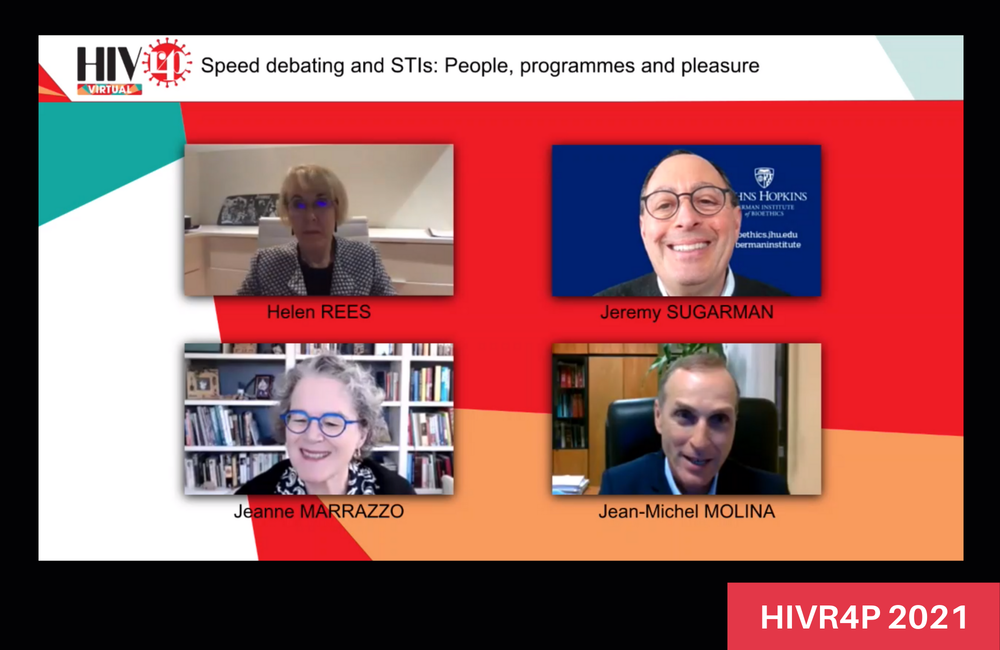
There is ongoing scientific debate regarding how best to prevent, manage and reduce rates of sexually transmitted infections (STIs). A possible future option is STI prophylaxis – taking medications either prior to (pre-), or shortly after (post-), exposure to an STI in order to prevent infection. However, this raises concerns regarding the development of antibiotic resistance, which would render medications less effective at treating STIs. Experts presented their opposing views to the virtual HIV Research for Prevention (HIVR4P) conference last week, with Professor Jeanne Marrazzo from the University of Alabama at Birmingham presenting arguments against STI prophylaxis, while Professor Jean-Michel Molina from the University of Paris presented data on instances where it may be beneficial.
Arguments against STI prophylaxis
Marrazzo argued that there is currently a lack of data regarding both the short and long-term effects of frequent antibiotic use over time; this is especially relevant because frequent dosing has been used in clinical trials and could be necessary for those at high risk of contracting STIs. Additionally, there has been an overfocus on the sexual health needs of men in clinical trials of STI prophylaxis, with very little attention given to the needs of women. Areas that could potentially be affected include reproductive health and the vaginal microbiome. While some MSM with high numbers of sexual partners are motivated to use STI prophylaxis, we don’t yet know about the sexual contexts that would encourage women to use it.
Antibiotic resistance poses a great threat when antibiotics are used indiscriminately. Bacteria develop resistance to certain antibiotics and these resistant strains circulate within the population, resulting in the failure of treatments that had previously worked. In the case of STIs for instance, gonorrhoea has evaded multiple classes of antibiotics. Most recently, it has become resistant to azithromycin and therefore, this antibiotic is no longer recommended for treatment. Marrazzo also highlighted inappropriate prescribing during the COVID-19 pandemic, adding to the challenges with antibiotic resistance.
Marrazzo concluded by stating: “‘We really should not be settling for a band-aid to promote sexual wellness.” Ultimately, a prophylactic approach to STI management fails to confront the underlying reasons for widespread STI epidemics and their sometimes severe outcomes, such as increased risk of certain cancers, congenital syphilis, infertility and elevated risk for contracting HIV. Marrazzo argued that instead, efforts should be focused on developing new vaccines, new treatments (such as new antibacterials for resistant strains), rapid and accurate diagnostic tests, and new delivery methods to enhance the uptake of treatment.
Arguments in favour of STI prophylaxis
Molina introduced his argument by underlining the strong need for STI prophylaxis in specific groups, such as some MSM who have higher STI rates. For instance, data from MSM taking pre-exposure prophylaxis for HIV (PrEP) in Australia showed a high incidence of STIs, with 2928 cases diagnosed in a group of 2981 men within a year. Interestingly, within this group, 25% of participants accounted for 76% of all STIs, indicating a specific subset of men who are at a higher risk of contracting an STI. Targeted STI prophylaxis would benefit groups such as these due to their increased risk and the possibility of onward transmission.
One approach already used to manage STIs is expedited (presumptive) treatment for sexual partners of an individual with a confirmed STI diagnosis, such as syphilis. This approach has been shown to successfully prevent syphilis developing in sexual contacts of individuals diagnosed within the preceding three months. It is recommended by the US Centers for Disease Control and Prevention (CDC) and represents an example of successful STI post-exposure prophylaxis (PEP).
Molina demonstrated the potential benefits of STI prophylaxis using data collected as part of the HIV PrEP French IPERGAY open-label extension study, which enrolled HIV-negative MSM at high risk of acquiring HIV and other STIs. Taking on-demand antibiotic PEP in the form of doxycycline resulted in a 70% drop in chlamydia infections and a 73% drop in syphilis. However, Molina emphasised that not all bacterial infections are the same – the doxycycline had no effect on gonorrhoea, with similar infections seen for both men taking it and those who did not.
While antibiotic resistance is a concern, there has been no documented resistance to doxycycline and other tetracycline antibiotics in either chlamydia or syphilis. Thus, for those STIs where prophylaxis has the potential to prevent infection, and where there is less chance of resistance developing, this approach could be feasible.
Molina concluded that more research is needed, especially on the efficacy and safety of doxycycline as a form of prophylaxis. He emphasised that it is not yet time for widespread use of a prophylactic approach for STIs. Instead, specific interventions aimed at groups at the highest risk of contracting STIs and as part of comprehensive management should be tested in studies.
The audience poll taken at the end of the debate reflected the divide regarding STI prophylaxis, with 37% against it, 43% for it and the rest undecided.
References
Marrazzo J & Molina JM. Post and Pre-Exposure Prophylaxis for STIs: Unwise in a time of antibiotic resistance. HIV Research for Prevention (HIVR4P) virtual conference, roundtable RT02, 2021.
